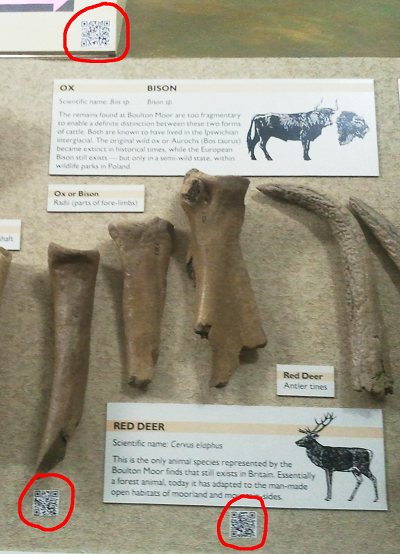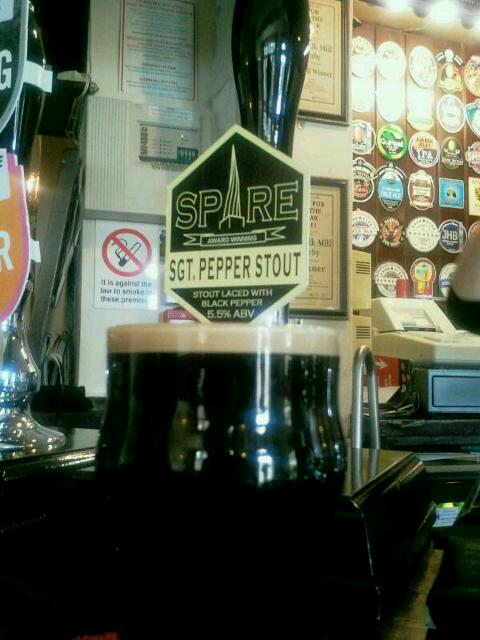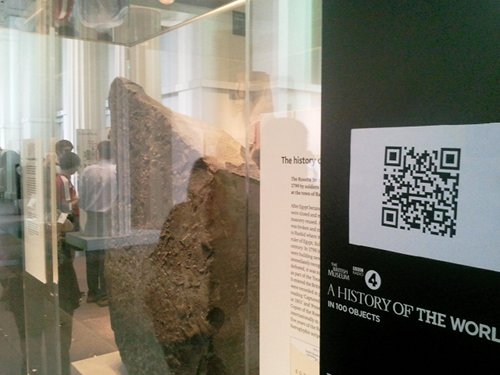It seems that all good ideas are invented simultaneously. Calculus was arrived at by both Leibniz and Netwon, Gray and Bell invented the telephone within days of each other, and the electric car is currenly being pursued by many different manufacturers.
Now it looks like sticking QR codes onto museum exhibits is the next big thing!
QRpedia is the venture I’m involved it, but I’ve recently become aware of Edinburgh Museum’s Tales of Things project and the QRator project of UCL.
Now, obviously, I’m biased towards QRpedia – but I wanted to jot down some quick thoughts on where I think QRator and Tales of Things may be going wrong.
Firstly, I’m enormously impressed with the scope of both projects. I don’t mean to denigrate them – I just want to point out how they could be made better.
Tales of Things
ToT has several deeply cool aspects. The ability to watch video and the ability to contribute UGC are two of the highlights. But it does, to my mind, have three serious deficiencies.
Firstly, it requires a proprietary app which only works on Android or iPhone. Got a BlackBerry, Nokia, or Windows Phone? Tough!
The app itself is fairly well thought out – but it’s nothing which couldn’t be done on a mobile website.

Which leads me on to the second flaw. What if you can’t install the app?
Scanning the code with any other phone leads the visitor to a non-mobile site!

To make matters worse, the video is presented in Flash which means it’s inaccessible to most phones and will be hard to stream unless you’ve got excellent mobile coverage.
Although there is a mobile internet signal in the gallery, it may be best to download and install the code reader before you visit the museum.
Tales of a Changing Nation Website
Finally, although they want people to comment on the exhibits, there’s a rather strong barrier to entry.
You’ll also need to register a username and password at www.talesofthings.com in order to submit your comments and memories.
Tales of a Changing Nation Website
Which means, I guess, either do it at home or find a free computer somewhere in the museum. Would it really have been so hard to create a mobile friendly sign up process?
QRator
I’ll be popping off to the Petrie Museum this weekend to play with their QR code installation. I’m not sure how or if it’s tied in to Tales of Things – they’re often mentioned together. One thing that strikes me is that it seems to revolves around having iPads located around the museum.
Buying a huge number of iPads feels like it’s an expensive extravagance. Yes, it shows off the exhibit nicely – but is it any better or cheaper than the touchscreen displays museums have had for years? Is there a risk that the iPads might go “wandering off”. Can the codes be scanned by normal phones?
All questions I hope to answer tomorrow!
QRpedia
Of course, it’s unfair of me to criticise QRator and Tales of Thing without subjecting QRpedia to the same treatment.
QRpedia has a number of deficiencies which we hope to address after our initial trials.
- No social media integration. There’s currently no way to “like” an object on Facebook or share it on Twitter.
- No video or sound. The Wikipedia page for The Beatles has lots of audio clips – but there are none on the mobile version. In general, there seem to be very few videos on Wikipedia and, because they are OGG formatted, rarely play on mobile.
- No commenting or other interaction.
- Museums can’t create their own page – they are reliant on Wikipedia.
- What to do about the iPad and other tablets? Currently QRpedia only shows the mobile version. Should tablets get taken to the full version? Or are tablet users happy to save the data charges and / or click on to the full versions themselves?
Internet Coverage
I’ve cheekily singled out Edinburgh Museum for potentially having poor coverage – in reality, it’s a problem in many museums. Most were designed before the ascendency of the mobile phone and, as a consequence, often struggle with 3G reception.
Even when they do have signal, it’s expensive for visitors from overseas to roam onto a network and download data.
One solution is free WiFi throughout a museum. Obviously, that’s an expense and has to be carefully managed to avoid abuse – but it would solve a problem common to all three approaches.
Overall
Despite my grumblings, I’m really excited to see more QR codes appear in museums. Anything which connects people to education is a great achievement.
I just want to make sure that the solutions which are deployed work well for everyone – no matter how expensive their phone.


















